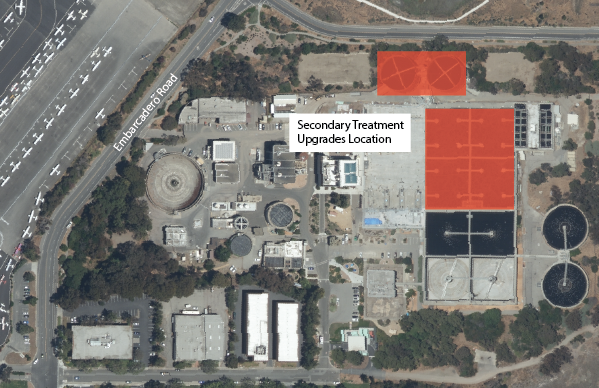Secondary Treatment Upgrades
- Project typeSystems Improvements
- Project value$193 million

Project Overview
This project will upgrade the Secondary Treatment process at the Regional Water Quality Control Plant to reduce organics, ammonia, and total nitrogen, or nutrients, in the Plant’s effluent. Nutrient loading is harmful to the Bay because it can contribute to algae blooms that kill fish and other aquatic life. The project replaces aging components of the existing secondary process, reconfigures the aeration basins, and uses a new treatment technology. The Plant is investing significantly in this upgrade to reduce its nutrients, meet pending regulations before they are in effect, and advance its sustainability goals.
The existing Secondary Treatment process has two main components: the Fixed Film Reactors (FFRs) and the Activated Sludge (AS) Process. The upgrades include the reconfiguration of the aeration basins, modification of the AS Process, and the elimination of the FFRs. The AS Aeration Basins will be subdivided with concrete walls creating different zones, in a serpentine pattern, where different pollutants can be treated. Some of the zones will operate with oxygen and others without oxygen. The treatment process will be intensified using Membrane Aerated Biofilm Reactors (MABR). The MABR convert nitrogen in the water to nitrogen gas which is released into the air. This byproduct is safe because nitrogen is the most abundant gas in the Earth’s atmosphere. The result will be a reduction of the total nitrogen in the treated wastewater by roughly half. All biological treatment will take place in the four retrofitted aeration basins.
Regulatory agencies are developing new compliance and permit requirements for total nitrogen. This upgrade prepares the Plant for that stricter regulation. Another driving factor for this project is that most equipment is beyond its useful life and in dire need of replacement. The components of the Secondary Treatment process are between 36 and 52 years old. They show extreme signs of wear and structural weakness. In addition, a special study was completed in 2017, which proposed a complete Secondary Treatment process upgrade instead of individual rehabilitation projects. The completion of the upgrades will meet the following objectives:
- Improve final water quality
- Ensure the Plant continues to meet effluent discharge permit limits
- Replace aging equipment or equipment beyond its useful life
- Allow for the ultimate decommissioning and removal of the aging FFRs
This project was identified in the Long-Range Facility Plan (LRFP) which was completed in 2012.
Scope of Work
- Rehabilitate secondary treatment facilities
- Provide nutrient removal to meet recent Bay discharge permit requirements
- Elevate or protect critical infrastructure based on sea level rise adaptation policies
- Decommission fixed film reactors
Public Impact
No public impacts are anticipated for this project.
Project Milestones
- September 2022 – Bid construction project
- December 2022 – Construction project awarded
- January 2023 – Construction started
- June 2028 – Construction completion
Project Documents
Long Range Facility Plan Final Report August 2012.pdf(PDF, 41MB)
Secondary Treatment Upgrades Before and After Photos.pdf(PDF, 2MB)
Project Location
2501 Embarcadero Way
